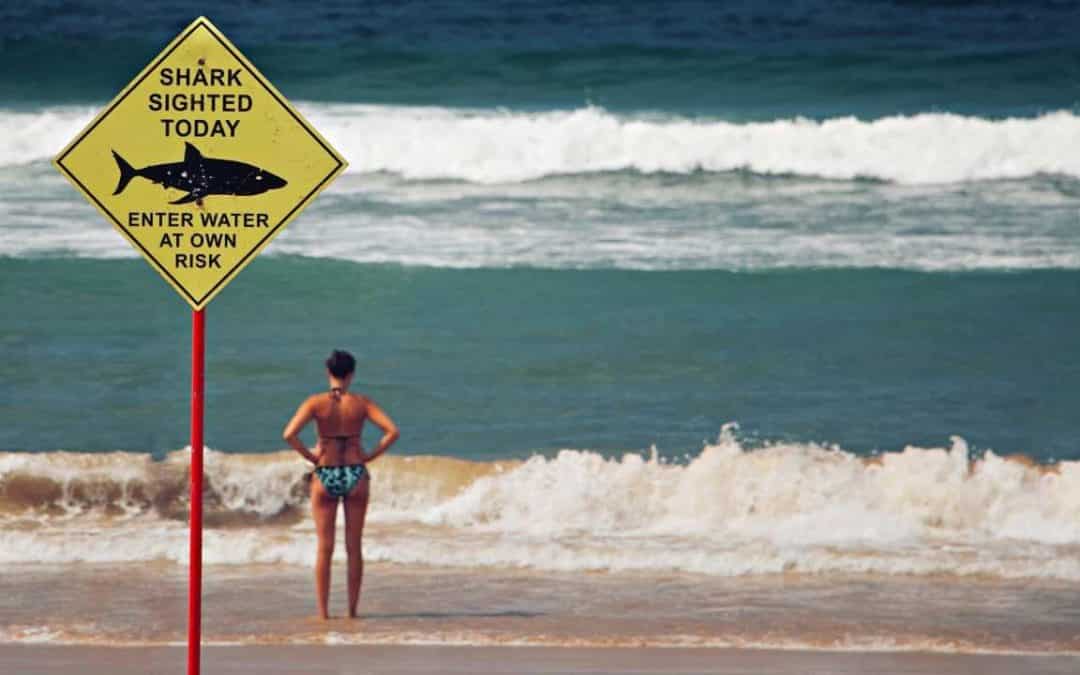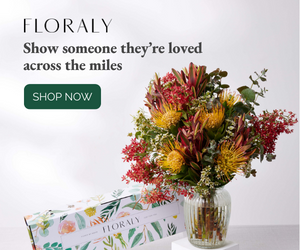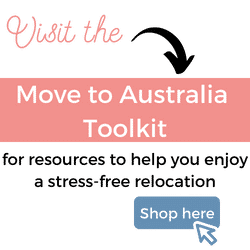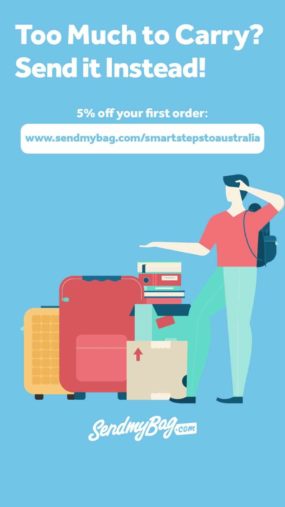Planning your move to Australia? Check out the range of services in the Move to Australia Directory!
When we told people we were moving to Australia, most of them commented on the dangerous animals and wildlife like the venomous snakes, dangerous spiders and the shark attacks. So many people told us they absolutely couldn’t consider living in Australia because of all of the dangerous and poisonous things in Australia.
Of course, Australia does have venomous animals, saltwater crocodiles and deadly creatures like the box jellyfish, but you just need to be sensible and be aware of these Australian animals. They really aren’t all out to get you and Australia isn’t a dangerous country.
Having lived here for almost eight years, the most dangerous encounter I’ve had was when I was stung by a few wasps when cutting down some branches in our garden, and something like that could easily have happened to me back in the UK too.
Putting the poisonous things in Australia into perspective
I’ve yet to see any dangerous snakes, venomous fish, dangerous birds or freshwater crocodiles roaming around! While these creatures do exist, Australian animals just want to be left alone and your chances of regularly meeting venomous creatures in urban areas (which, let’s face it, is where most of us live) are pretty low. It is important to be informed though so you know what dangers are out there, how to avoid coming into contact with them and what to do if you do get bitten or stung.
I wanted to put together this list of poisonous and dangerous animals in Australia so you can learn more about them so you can get the facts rather than listening to the fearsome reputation Australia has for being home to the deadliest animals in the world. There is a very good chance that you will never encounter any of these deadly creatures unless you go searching for them! And even if you ever did come into contact with one of them, most of the time they’ll be more scared of you than you are of them.
I hate to think about people not following their dreams because of their fear about poisonous things in Australia. Please be informed and sensible but not fearful of Australia’s wildlife.
I’ve told this story a few times before but, in the UK, my husband almost died from a snake bite. As a child, he picked up an adder thinking it was a slow worm. It bit him and he was very lucky to survive. Yet we don’t think of the UK as being infested with snakes! I know a few people who’ve been bitten by dogs in the UK, and there are often dog attacks on the news. That doesn’t stop people from visiting or from living there. Keep things in perspective! There are dangerous animals and poisonous creatures everywhere, not just in Australia!
Let’s dive into this list of five dangerous creatures and poisonous things in Australia…
Crocodiles in Australia: Dangerous things in Australia
Australia is home to two species of crocodiles: the saltwater crocodile (known as a ‘salty’) and the freshwater crocodile. Saltwater crocs are the larger of the two, growing up to 6m in length.
Crocodiles live in the top end of the country. In Queensland, crocodile country begins just south of Gladstone and runs up the coast and across Far North Queensland (so you won’t find crocs in Brisbane, on the Sunshine Coast or on the Gold Coast!). In Western Australia, crocs have been sighted as low as Shark Bay and Exmouth (so again you won’t find crocs in Perth, Mandurah or Margaret River). You will find crocodiles across the Northern Territory.
Crocodiles can be more aggressive during the breeding season which is September – April, so avoiding crocodile nests then is important as they will be in protective mode.
If you live in Brisbane, Melbourne, Perth, Canberra, Hobart or Sydney, you won’t see crocodiles in the rivers or lakes so they really don’t need to be something you’re concerned about unless you plan on living in northern Australia. Even if you do end up living or travelling further north, it’s all about being aware of your surroundings, following a few simple rules and using your common sense.
Crocodile safety rules
There are some simple but obvious rules to stay safe around crododiles in Australia.
- Keep an eye out for crocodile warning signs
- Don’t swim in waters that are known to have crocodiles in them
- Don’t camp in areas with crocs
- Don’t lean over boats or get too close to the water’s edge.
Do you need to be scared of crocodiles in Australia?
I don’t think so. You just need to be sensible and aware if you’re in an area where crocs can be found.
How many crocodile attacks in Australia per year?
If you’re wondering how many crocodile attacks happen in Australia every year, it’s really not that many compared with the population of crocodiles (over 100k) and the number of people living here. Over a 33-year period, it was tracked that around 1.9 crocodile attacks happened per year.
Jellyfish and marine creatures in Australia: Poisonous things in Australia
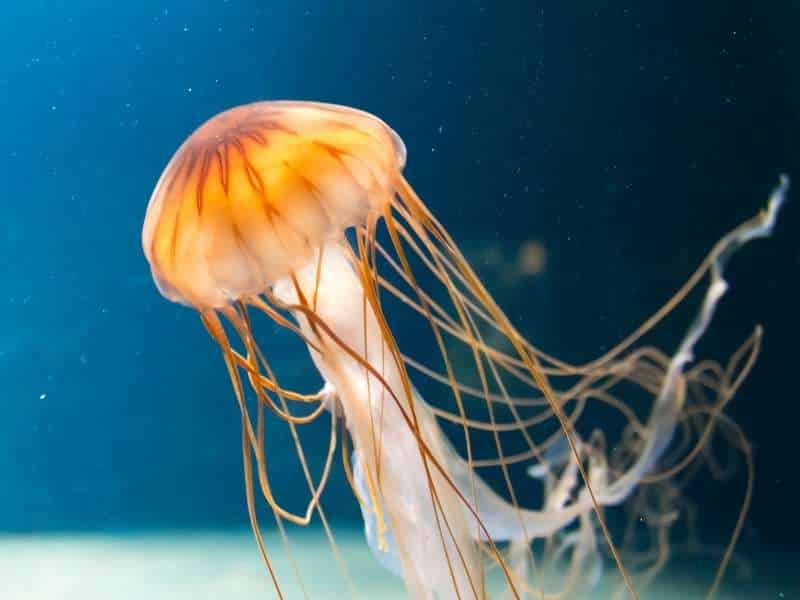
Jellyfish are something you need to be aware of in Australia as they are more common (although the deadlier species of jellyfish are limited to certain areas and particular times of the year).
While some jellies can give you a painful sting, others have a deadly venom. The box jellyfish, for instance, is the most venomous marine creature in the world. It’s important to know what to do with jellyfish stings in case you ever encounter one, and to know where the dangerous jellyfish can be found around Australia’s coastline.
Box jellyfish in Australia
Let’s start with box jellyfish (scientific name: Chironex fleckeri). The body of this deadly species is shaped like a box and they have tentacles loaded with poison. Being stung by these can result in paralysis or cardiac arrest, or even death. As the stingers are in their tentacles, the severity of the sting depends on how many of them touch the victim. Either way, the sting can cause intense pain, and muscle spasms, and they can damage the muscles around the lungs and heart.
Box jellyfish can reach up to a foot in size although they have long, dangling tentacles which trail in the water making them much larger.
You’ll find box jellyfish more prevalent in the summer off the coast in the northern section of the country (Northern Territory, north Queensland and north Western Australia). There have been just 70 recorded cases of deaths in Australia caused by box jellyfish stings and all of these were recorded during the summer months (Oct – May) so again, keeping this in perspective numbers are low.
Irukandji jellyfish in Australia
Irukandji jellyfish may be tiny but they are another type of Australian jellyfish that fall into Australia’s most deadly creatures category. Being stung by their deadly venom can cause severe pain and the danger of a fatal brain haemorrhage. Irukandji syndrome can cause intense pain, muscle cramping hypertension and cardiac issues. You can find Irukandji jellyfish in the northern waters of Queensland, the Northern Territory and the northern waters of Western Australia.
Unlike most jellyfish, which have stingers only on their tentacles, the Irukandji also has stingers on its bell. These jellyfish send around 50 – 100 people to hospital a year. You can get treatment for a sting though, so fatal injuries are rare.
Blue-ringed octopus
The blue-ringed octopus is another type of venomous octopus that can be found in tide pools and coral reefs in Australian waters. They are great at hiding and camouflage but you can recognise them from their blue rings markings. Although small, their bites are toxic but painless and often someone doesn’t know they’re bitten until they begin having difficulty breathing.
There is no known antivenom for blue-ringed octopus stings. Despite this danger, only two deaths have been recorded in Australia due to blue-ringed octopus stings, so again it’s very rare.
Cone snails in Australia
I had no idea Australia was home to dangerous marine snails until I began writing this article about poisonous things in Australia. They’re mostly found in Australia’s tropical and sub-tropical waters but they can also be found in southern Australia too.
Cone snails have venom glands that supply sharp barbs which they then inject into their victims. Cone snail shells are pretty, so beware if you enjoy scouring the sand for shells as they might still have a creature living inside.
You aren’t likely to come into contact with a cone snail though unless you’re a diver and decide to pick one up.
If you are unlucky enough to get stung by a cone snail, their sting gives severe pain and numbness, although in severe cases it can lead to breathing paralysis and even death. Hospital attention should be sought as soon as possible.
How to avoid venomous jellyfish stings in Australia?
- Always check and take notice of signs at beaches as these will alert you to risks.
- Some northern beaches have jellyfish nets to protect you. If they are available, use them.
- Swim where there are lifeguards. If you need any first aid, it means there is someone there to help.
- Wear stinger suits if swimming in tropical waters during stinger season (when you do tours like the Great Barrier Reef tours or Whitsunday Island tours, these are usually provided for you so make sure you wear them even if you feel silly! When I did a Whitsunday tour, a young girl thought she was too cool to wear one and she was stung by a jellyfish when she jumped in. She was absolutely terrified as she didn’t know if it was a harmless one or a dangerous one and it completely ruined her experience of visiting Whitehaven Beach. Thankfully for her, it turned out to be a harmless one, but she definitely regretted her decision not to put on the suit!).
- Take extra care in rock pools and shallow water around boat ramps. I personally like my kids to wear reef shoes when they’re hunting around rock pools and rocky areas.
What to do if you get stung by a jellyfish?
For minor but painful jellyfish stings (bluebottle jellyfish and other non toxic jellyfish), you should wash the sting and remove any tentacles that are still on the skin. Next, immerse the skin in hot water – as hot as you can stand without burning. If you can’t get to hot water, use an ice pack to soothe the pain.
For box jellyfish and irukanji jellyfish stings, call triple zero 000 for an ambulance. Next, apply plenty of vinegar if you have access to any, and remove the tentacles. For blue-ringed octopus bites, first aid involves calling for an ambulance and applying pressure to the wound – respiratory support is needed urgently and although there is no ‘cure’ patients can be placed on a ventilator until the toxin is removed from the body.
You can find a full jellyfish first aid guide here.
Snakes in Australia: Poisonous things in Australia
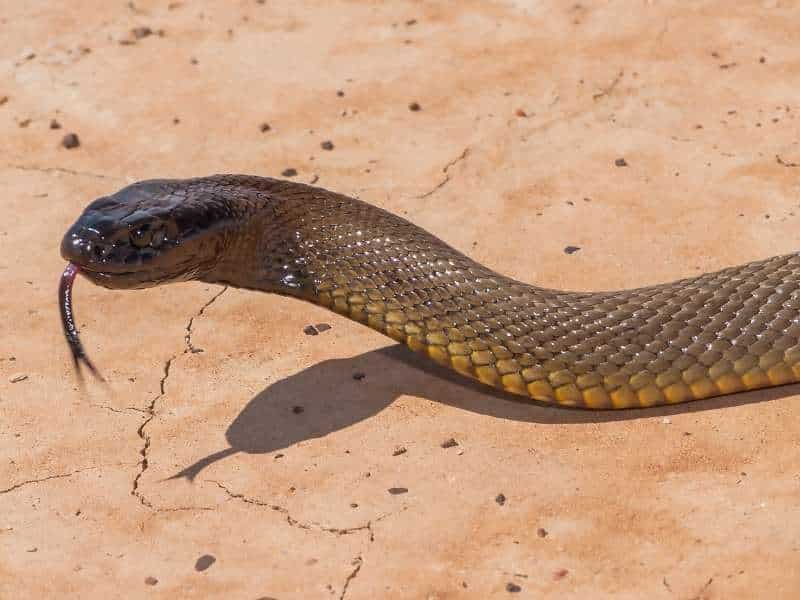
Australia is home to dangerous snake species but the reality is that very few people die from a snake bite here. Like the rest of the deadliest animals, snakes don’t want to give you a venomous bite. They just want to mind their own business and stay away from you! We’re much too big for them to eat and their venom is meant to disable their prey while they feed.
Australia’s dangerous snakes include: Eastern brown snake (brown snakes have a powerful venom but there is an antivenom available), tiger snake (another venomous land snake to be aware of but again anti venom is available), inland taipan and coastal taipans, common death adder, red-bellied black snake (thankfully their bites may be painful but they’re less deadly).
Sea snakes also pose a risk as they hold enough venom to kill 22 people in their hook-nose (thankfully most species of sea snakes aren’t actually dangerous though and your chances of ever meeting a dangerous one is slim)!
How common are snakes in Australia?
How common snakes are depends on where you live. I’m in north Brisbane in a built up area, and I’ve seen non-venomous tree snakes and keelback snakes here a couple of times while walking around our local lake. I’ve seen a couple of non-venomous snakes up in Noosa on trips, and on island tours that take you into open forests. I know a few people nearby who have had a carpet python in their garden – while these aren’t venomous they are large snakes that can eat birds and small mammals.
If you live more rurally, you will be more likely to see snakes. Even in urban areas, it’s important to know there are snakes around, even if you can’t see them, but most of the time they won’t cause you any bother at all.
I’m not a snake-lover by any means, but I know that on hikes, in a forest or around lakes there could be snakes. I’m in their domain after all! We’ve never seen a snake in our garden, and it’s not something I think about much other than taking a few simple precautions.
Snake bite first aid
You can watch a first aid video about what to do in the event of a snake bite in this post.
Do I need to be scared of snakes in Australia and how can I avoid snakes in Australia?
You need to be aware of snakes, but not scared of them. They would much rather not come into contact with you!
Here are some ways to avoid dangers around snakes:
- Be careful where you step as most snake bites occur not because it’s a particularly fierce snake but because it was stepped on and was protecting itself.
- Seal gaps in your home so nothing can get in, and don’t leave doors open (most doors have fly screens anyway).
- Don’t leave small pets unattended outside (I’m extra cautious of our chihuahua).
- Don’t pile up garden rubbish or rubble as this can make a great home for a snake.
- Keep your grass cut short.
- If you’re walking outside at night time take a torch so you can see anything ahead of you.
Sharks in Australia: Deadly things in Australia
There are many species of sharks in Australia’s coastal waters and they’re important for our marine ecosystem. The marine environment is their home, so when we choose to enter the ocean at our popular beaches (even in shallow water), we are entering into the shark’s domain.
Sharks don’t all want to eat you – I’ve snorkelled many times with reef sharks – it’s an incredible experience! When shark attacks do happen, it’s thought it’s often a result of mistaken identity as a swimmer can easily be mistaken for a seal. But you do need to be aware of the dangers of sharks in Australia.
Great white sharks, bull sharks and tiger sharks account for most of the shark attacks that do occur in Australia. Attacks can happen all around Australia in our tropical waters. In 2021, New South Wales had the highest number of attacks, followed by Western Australia.
Shark attacks, and shark fatalities, in particular, are still very rare in Australia given how many people swim and surf in our oceans every day. The oceans are an important part of our lives in Australia because we love the beach so much! We just need to be sensible and take some precautions when entering the ocean.
Do you need to be scared of sharks in Australia?
You need to be aware of them, but shark attacks are rare. There are precautions you can take.
Tips for avoiding shark attacks in Australia:
- Swim at beaches with lifeguard stations. Patrols will be on the lookout for any potential dangers, and in the event of any issues, you’ll have medical support available.
- Avoid swimming or surfing alone – there is safety in numbers as sharks may avoid groups. It also means you have backup in case you need any help.
- Don’t swim in cloudy, choppy water.
- Don’t swim right after storms as baitfish can be stirred up which can attract sharks.
- Choose the time of day wisely – don’t swim or surf at dawn or dusk as this is when sharks will be more active.
- Be aware of your surroundings – look around before you get in the water.
- Don’t splash around in the water.
- Avoid swimwear that is shiny, brightly coloured (especially yellow) or white. Apparently, this attracts sharks.
Spiders in Australia: Poisonous things in Australia
Like a lot of people, I hate the idea of venomous spiders in Australia. We get some big spiders in Australia like giant huntsman spiders, and we get some that can be dangerous like the redback spider, the Sydney funnel web spider and the recluse spider. There’s also the ugly-looking mouse spider and wolf spider, and my son’s particular favourite – the bird-eating spider, also known as the Queensland bird-eating spider or the Australian tarantula *shudders*.
There are lots of spider species in Australia and some give nasty spider bites and others don’t have toxic venom. Some are big and some are small.
There have been no deaths from spider bites in Australia since 1979, so that says a lot about how dangerous spiders are in Australia. There are anti-venoms available for lots of types of spider bites. Bites from many spiders can cause an allergic reaction or a localised reaction such as swelling or local pain too, and this might only require over-the-counter medicines but it’s always a good idea to get any spider bites checked out.
What to do if somebody gets a spider bite?
Visit Health Direct for guidance on how to manage different types of spider bites.
Should I be scared of spiders in Australia?
You will be more likely to come into contact with spiders than any other deadly animal on this list of poisonous things in Australia, even if you live in an urban area.
If you are scared of spiders, you can get your house sprayed by a pest control company. Some houses seem to attract more spiders than others – we’ve had our home sprayed once in seven years and we very rarely ever find a spider in the house so I haven’t bothered to have it done again.
We definitely have a lot less spiders in our home here in Australia than I did in the UK. But I think it’s region-dependent as I know other people who do have to keep up their pest sprays otherwise they find spiders and cockroaches appearing. Either way, a pest spray isn’t expensive and for peace of mind it can be money well spent.
Tips to avoid spider dangers
- Be aware when gardening – wear gloves and be aware of where you’re putting your hands.
- At night, be extra careful. We often have garden orb weavers that spin a web across our driveway or between trees and then, in the morning, they pack their web neatly away again. They come back night after night to the same spots so we know to go out with a torch if we leave the house at night as we definitely don’t want to walk into a face full of spiders in the night!!!!! (They aren’t small spiders either!) Once you know this is a thing, you take a lot more notice of where you’re walking at night!
- If you’re walking through gardens or parkland, be aware there could be webs strung between trees and bushes (especially if you’re on an early walk so you’re the first person of the day to pass through).
- Check outdoor furniture before sitting down.
- If you’re camping, check toilets and showers (I’ve only seen one redback spider before and it was hanging above me in a shower at the Uluru campground!!!)
- Be careful with any camping gear which may have been stored in a shed or garage in case a spider has sneaked into it.
- Keep a bug spray to hand. I prefer to catch them and put them outside if I can, but I like knowing I have a few cans of spray in the house for an emergency situation!
I dislike spiders, but I know they’re more scared of me than I am of them. I love living here because I see less spiders than I did in the UK, so as a non-spider lover, I’d actually say Australia is better!
Poisonous things in Australia aren’t out to get you
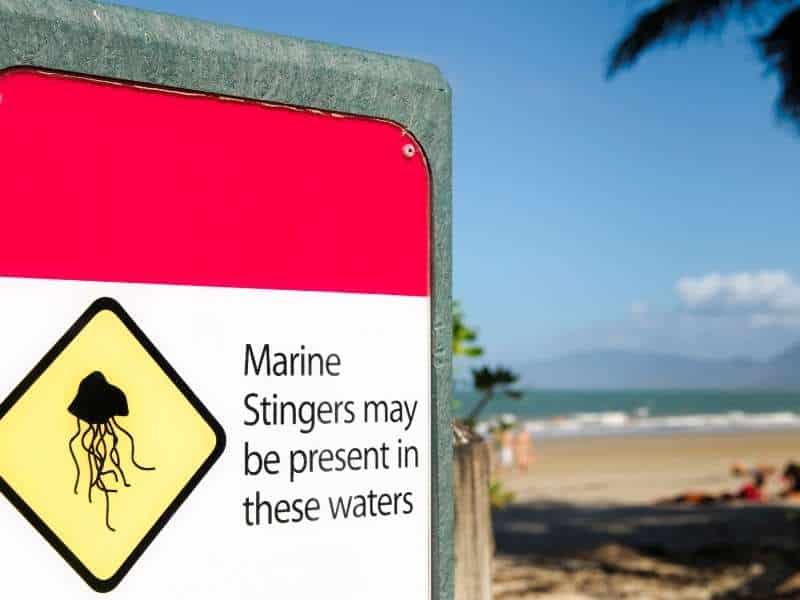
There are lots of poisonous things in Australia, but the media hype really focuses too much on these rare instances rather than the realities of life Down Under.
We can live alongside these venomous creatures without having too much of an impact on one another’s lives. We aren’t surrounded by snakes, spiders and sharks every day (well I guess we kind of are, but we just don’t see them and they don’t interfere with our lives)!
It’s rare for the poisonous things in Australia to actually cause major harm to somebody. With our excellent medical services, treatment such as anti-venoms, and a bit of common sense to avoid the dangers in the first place, the risks are very low.
The next time somebody tells you they couldn’t emigrate because of all of the poisonous things in Australia, rather than focussing on all of the sharp claws, potent venom and fangs, remind them of all of the incredible non-poisonous wildlife we have – our cuddly koalas, platypus, dingoes, wombats, possums and kangaroos!
That aside, Australia’s wildlife is all amazing (even the deadly and poisonous things in Australia) when you step back and think about it. Apart from mosquitos. I won’t lie, they are a big pain and I hate them!

